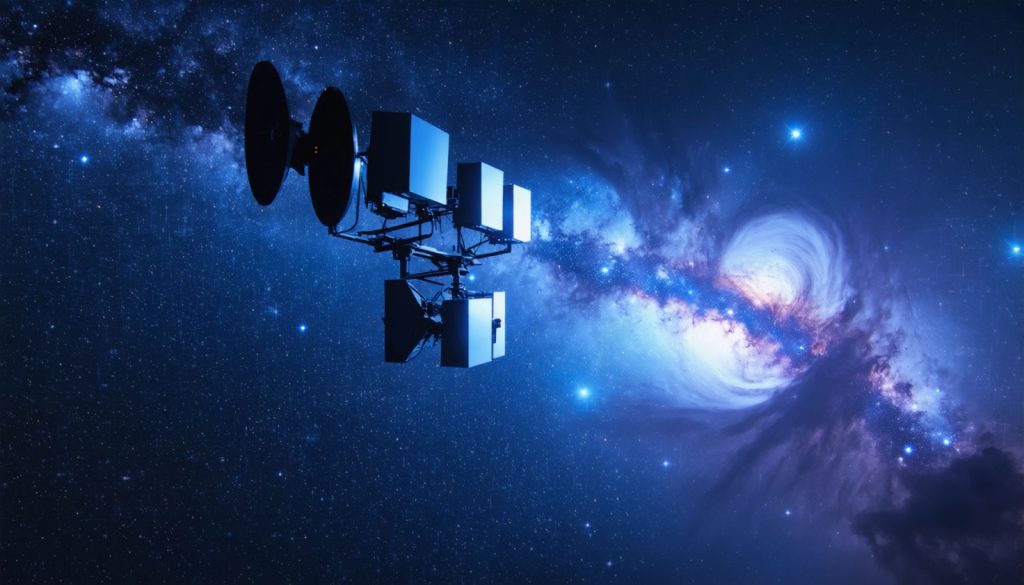
- Space surveillance is essential for safeguarding modern life, monitoring over 27,000 man-made objects in Earth’s orbit to prevent collisions and maintain order.
- The U.S. Space Surveillance Network acts as a key sentinel, utilizing telescopes and radar stations worldwide.
- Space debris poses a growing threat; a single collision can cause widespread chaos, as seen in the Iridium 33 and Kosmos 2251 incident.
- With the rise in satellite launches, ongoing vigilance is crucial to avoid such disasters.
- Space surveillance protects vital assets like GPS and weather satellites from cosmic threats, including solar storms.
- International cooperation and advanced technology are vital for maintaining a safe orbital environment, emphasizing cosmic responsibility.
In the vast expanse above, a silent guardian watches over us, cloaked in the anonymity of the cosmos. Space surveillance, though largely out of public sight, plays a crucial role in safeguarding our modern way of life. As satellites zip around Earth orbiting at breathtaking speeds, their vigilance ensures that we sleep a little sounder each night.
Guardians of the Night Sky
Imagine the night sky as a vast ocean bustling with invisible ships, each on a unique trajectory. Space surveillance systems act as vigilant lighthouse keepers, tracking these vessels with precision. The United States’ Space Surveillance Network is one such sentinel, monitoring over 27,000 man-made objects orbiting Earth. This colossal task requires a fleet of telescopes and radar stations scattered globally, all working in tandem to prevent cosmic chaos.
The Dance of Debris
Space debris, a growing concern, resembles a tempest in this celestial ocean—a tempest that can spell disaster. A single collision in space can send thousands of fragments hurtling across the heavens, each potentially catastrophic to operational satellites. In 2009, the collision between Iridium 33 and Kosmos 2251 satellites served as a wake-up call, illustrating the grave consequences of space neglect. With thousands of satellites slated for launch in the coming years, space surveillance ensures that such collisions remain rare exceptions rather than the norm.
The Eyes of the Universe
From GPS systems guiding us through city streets to weather satellites predicting storms, our dependence on space-based technology is profound. Surveillance systems continuously monitor not just for debris but also for potential solar storms—a cosmic threat that can wreak havoc on our fragile electronic lifelines. Protecting these assets demands state-of-the-art technology and relentless vigilance.
A Call for Cosmic Responsibility
Amidst this vigilance, a call for responsibility echoes across nations. International cooperation, combined with cutting-edge technology, shapes the future of space exploration and safety. More countries recognize the stakes in maintaining a pristine orbital environment, leading to discussions on space traffic management and debris mitigation.
The takeaway is clear: space surveillance is not just the unseen fortress guarding our skies, but a testament to human cooperation and technological prowess. As we continue our dance among the stars, let us remember the guardians who ensure our place in the cosmic ballet remains secure.
The Hidden Heroes of Space: Unveiling the Silent Sentinels Above
Introduction
Space surveillance is not just an abstract concept; it is the backbone of modern satellite technology that supports everyday life on Earth. From ensuring network connectivity to protecting national security interests, these systems are critical yet often overlooked. This article dives deeper into the roles, technologies, and future challenges of space surveillance, offering practical insights and actionable recommendations for understanding this vital field.
How Space Surveillance Works
Space surveillance involves tracking and monitoring satellites and debris orbiting Earth. The systems used include ground-based radar and optical telescopes, as well as space-based sensors. The primary tasks are:
– Tracking: Monitoring the position and trajectory of objects in space.
– Identifying: Cataloging objects to differentiate between operational satellites and debris.
– Orbit Prediction: Calculating potential future collisions and devising avoidance maneuvers.
How-To Steps for Improving Space Surveillance
1. Upgrade Radar Systems: Enhancing sensitivity and range to detect smaller debris.
2. Increase International Collaboration: Share data among countries to improve the global satellite tracking system.
3. Invest in AI and Machine Learning: Use these technologies for better predictive analytics in space object trajectory prediction.
4. Develop Active Debris Removal Technologies: Innovate ways to reduce space debris, such as nets, harpoons, or robotic arms.
Real-World Use Cases
– Military Operations: Surveillance helps monitor potentially hostile satellites and space activities.
– Disaster Response: Space surveillance contributes to environmental monitoring, aiding in the analysis and response efforts to natural disasters.
– Commercial Satellite Management: Companies rely on space surveillance to ensure the safety of communications satellites.
Industry Trends and Market Forecasts
The global space surveillance industry is expected to grow significantly, driven by the increasing number of satellites and the need for comprehensive space traffic management. According to research, the market may reach a valuation of several billion dollars by 2030, focusing on developing new tracking technologies and debris mitigation solutions.
Reviews & Comparisons
– U.S. Space Surveillance Network vs. European Space Agency’s SSA: The U.S. network is currently more extensive, but the ESA is advancing rapidly with new initiatives and technologies.
– Radar vs. Optical Systems: Radars are effective for tracking larger objects at greater distances, while optical systems are superior in identifying smaller objects.
Controversies and Limitations
– Privacy Concerns: Monitoring capabilities raise questions about privacy and surveillance beyond Earth’s orbit.
– Debris Mitigation Challenges: Effective cleanup of space junk is still a technological and economic challenge.
Features and Specs
– Advanced Radar Systems: Include phased-array radars with capabilities to track multiple objects simultaneously.
– Space-Based Sensors: Deployed on satellites, provide a unique perspective not hindered by atmospheric interference.
Security and Sustainability
– Data Security: Ensuring the integrity of satellite data is critical for national security and commercial operations.
– Sustainability Initiatives: Programs promoting the sustainable use of space, like the Kessler Syndrome management, are vital for long-term orbital health.
Insights and Predictions
As we move towards the 2030s, we can expect more international frameworks and treaties governing space traffic, advances in AI-driven solutions for orbit management, and increased private-sector participation in space surveillance activities.
Actionable Recommendations
– Stay Informed: Keep abreast of developments in space technology and policy changes.
– Support Space Sustainability Efforts: Advocate for policies that prioritize space debris mitigation and international cooperation.
Space surveillance is an invisible yet integral guardian of our modern existence. By understanding its mechanisms and challenges, we contribute to a more sustainable and secure future.



